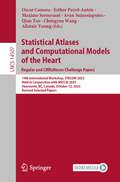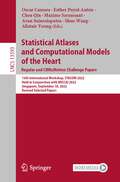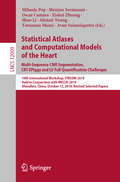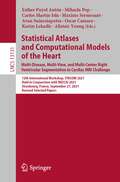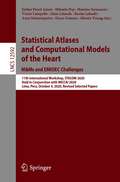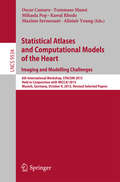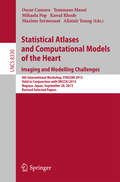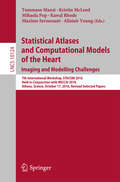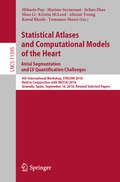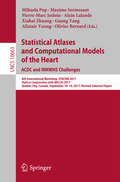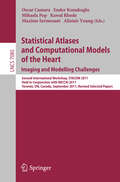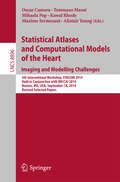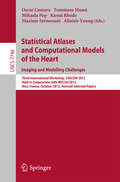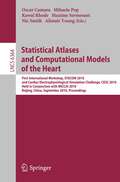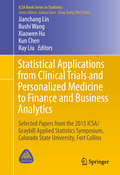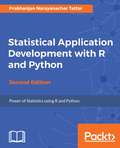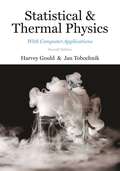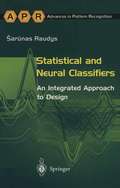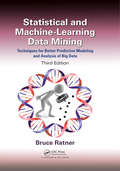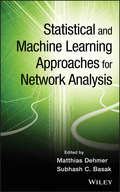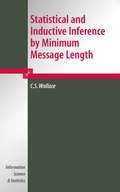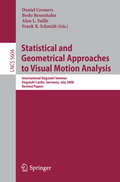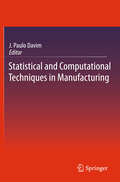- Table View
- List View
Statistical Atlases and Computational Models of the Heart. Regular and CMRxRecon Challenge Papers: 14th International Workshop, STACOM 2023, Held in Conjunction with MICCAI 2023, Vancouver, BC, Canada, October 12, 2023, Revised Selected Papers (Lecture Notes in Computer Science #14507)
by Oscar Camara Esther Puyol-Antón Maxime Sermesant Avan Suinesiaputra Qian Tao Chengyan Wang Alistair YoungThis book constitutes the proceedings of the 14th International Workshop on Statistical Atlases and Computational Models of the Heart, STACOM 2023, as well as the Cardiac MRI Reconstruction Challenge, CMRxRecon Challenge. There was a total of 53 submissions to the workshop. The 24 regular workshop papers included in this volume were carefully reviewed and selected from 29 paper submissions. They deal with cardiac segmentation, modelling, strain quantification, registration, statistical shape analysis, and quality control. In addition, 21 papers from the CMRxRecon challenge are included in this volume. They focus on fast CMR image reconstruction and provide a benchmark dataset that enables the broader research community to promote advances in this area of research.
Statistical Atlases and Computational Models of the Heart. Regular and CMRxMotion Challenge Papers: 13th International Workshop, STACOM 2022, Held in Conjunction with MICCAI 2022, Singapore, September 18, 2022, Revised Selected Papers (Lecture Notes in Computer Science #13593)
by Oscar Camara Esther Puyol-Antón Chen Qin Maxime Sermesant Avan Suinesiaputra Shuo Wang Alistair YoungThis book constitutes the proceedings of the 13th International Workshop on Statistical Atlases and Computational Models of the Heart, STACOM 2022, held in conjunction with the 25th MICCAI conference. The 34 regular workshop papers included in this volume were carefully reviewed and selected after being revised and deal with topics such as: common cardiac segmentation and modelling problems to more advanced generative modelling for ageing hearts, learning cardiac motion using biomechanical networks, physics-informed neural networks for left atrial appendage occlusion, biventricular mechanics for Tetralogy of Fallot, ventricular arrhythmia prediction by using graph convolutional network, and deeper analysis of racial and sex biases from machine learning-based cardiac segmentation. In addition, 14 papers from the CMRxMotion challenge are included in the proceedings which aim to assess the effects of respiratory motion on cardiac MRI (CMR) imaging quality and examine the robustness of segmentation models in face of respiratory motion artefacts. A total of 48 submissions to the workshop was received.
Statistical Atlases and Computational Models of the Heart. Multi-Sequence CMR Segmentation, CRT-EPiggy and LV Full Quantification Challenges: 10th International Workshop, STACOM 2019, Held in Conjunction with MICCAI 2019, Shenzhen, China, October 13, 2019, Revised Selected Papers (Lecture Notes in Computer Science #12009)
by Mihaela Pop Maxime Sermesant Oscar Camara Xiahai Zhuang Shuo Li Alistair Young Tommaso Mansi Avan SuinesiaputraThis book constitutes the thoroughly refereed post-workshop proceedings of the 10th International Workshop on Statistical Atlases and Computational Models of the Heart: Atrial Segmentation and LV Quantification Challenges, STACOM 2019, held in conjunction with MICCAI 2019, in Shenzhen, China, in October 2019. The 42 revised full workshop papers were carefully reviewed and selected from 76 submissions. The topics of the workshop included: cardiac imaging and image processing, machine learning applied to cardiac imaging and image analysis, atlas construction, statistical modelling of cardiac function across different patient populations, cardiac computational physiology, model customization, atlas based functional analysis, ontological schemata for data and results, integrated functional and structural analyses, as well as the pre-clinical and clinical applicability of these methods.
Statistical Atlases and Computational Models of the Heart. Multi-Disease, Multi-View, and Multi-Center Right Ventricular Segmentation in Cardiac MRI Challenge: 12th International Workshop, STACOM 2021, Held in Conjunction with MICCAI 2021, Strasbourg, France, September 27, 2021, Revised Selected Papers (Lecture Notes in Computer Science #13131)
by Oscar Camara Mihaela Pop Maxime Sermesant Alistair Young Avan Suinesiaputra Karim Lekadir Esther Puyol Antón Carlos Martín-IslaThis book constitutes the proceedings of the 12th International Workshop on Statistical Atlases and Computational Models of the Heart, STACOM 2021, as well as the M&Ms-2 Challenge: Multi-Disease, Multi-View and Multi-Center Right Ventricular Segmentation in Cardiac MRI Challenge.The 25 regular workshop papers included in this volume were carefully reviewed and selected after being revised. They deal with cardiac imaging and image processing, machine learning applied to cardiac imaging and image analysis, atlas construction, artificial intelligence, statistical modelling of cardiac function across different patient populations, cardiac computational physiology, model customization, atlas based functional analysis, ontological schemata for data and results, integrated functional and structural analyses, as well as the pre-clinical and clinical applicability of these methods. In addition, 15 papers from the M&MS-2 challenge are included in this volume. The Multi-Disease, Multi-View & Multi-Center Right Ventricular Segmentation in Cardiac MRI Challenge (M&Ms-2) is focusing on the development of generalizable deep learning models for the Right Ventricle that can maintain good segmentation accuracy on different centers, pathologies and cardiac MRI views. There was a total of 48 submissions to the workshop.
Statistical Atlases and Computational Models of the Heart. M&Ms and EMIDEC Challenges: 11th International Workshop, STACOM 2020, Held in Conjunction with MICCAI 2020, Lima, Peru, October 4, 2020, Revised Selected Papers (Lecture Notes in Computer Science #12592)
by Esther Puyol Anton Mihaela Pop Maxime Sermesant Victor Campello Alain Lalande Karim Lekadir Avan Suinesiaputra Oscar Camara Alistair YoungThis book constitutes the proceedings of the 11th International Workshop on Statistical Atlases and Computational Models of the Heart, STACOM 2020, as well as two challenges: M&Ms - The Multi-Centre, Multi-Vendor, Multi-Disease Segmentation Challenge, and EMIDEC - Automatic Evaluation of Myocardial Infarction from Delayed-Enhancement Cardiac MRI Challenge. The 43 full papers included in this volume were carefully reviewed and selected from 70 submissions. They deal with cardiac imaging and image processing, machine learning applied to cardiac imaging and image analysis, atlas construction, artificial intelligence, statistical modelling of cardiac function across different patient populations, cardiac computational physiology, model customization, atlas based functional analysis, ontological schemata for data and results, integrated functional and structural analyses, as well as the pre-clinical and clinical applicability of these methods.
Statistical Atlases and Computational Models of the Heart. Imaging and Modelling Challenges: 6th International Workshop, STACOM 2015, Held in Conjunction with MICCAI 2015, Munich, Germany, October 9, 2015, Revised Selected Papers (Lecture Notes in Computer Science #9534)
by Oscar Camara Tommaso Mansi Mihaela Pop Kawal Rhode Maxime Sermesant Alistair YoungThis book constitutes the thoroughly refereed post-workshop proceedings of the 6th International Workshop on Statistical Atlases and Computational Models of the Heart: Imaging and Modelling Challenges, STACOM 2015, held in conjunction with MICCAI 2015, in Munich, Germany, in October 2015. The 23 revised full workshop papers were carefully reviewed and selected from 34 submissions. The papers cover a wide range of topics such cardiac image processing, atlas construction, statistical modeling of cardiac function across different patient populations, cardiac mapping, cardiac computational physiology, model customization, image-based modelling and image-guided interventional procedures, atlas based functional analysis, ontological schemata for data and results, integrated functional and structural analysis.
Statistical Atlases and Computational Models of the Heart. Imaging and Modelling Challenges: 4th International Workshop, STACOM 2013, Held in Conjunction with MICCAI 2013, Nagoya, Japan, September 26, 2013. Revised Selected Papers (Lecture Notes in Computer Science #8330)
by Oscar Camara Tommaso Mansi Mihaela Pop Kawal Rhode Maxime Sermesant Alistair YoungThis book constitutes the thoroughly refereed post-conference proceedings of the 4th International Workshop on Statistical Atlases and Computational Models of the Heart: Imaging and Modelling Challenges, STACOM 2013, held in conjunction with MICCAI 2013, in Nagoya, Japan, in September 2013. The 31 revised full papers were carefully reviewed and selected from numerous submissions. The papers are organized in topical sections on cardiac image processing; atlas construction; statistical modelling of cardiac function across different patient populations; cardiac mapping; cardiac computational physiology; model customization; atlas based functional analysis; ontological schemata for data and results; integrated functional and structural analyses; as well as the pre-clinical and clinical applicability of these methods.
Statistical Atlases and Computational Models of the Heart. Imaging and Modelling Challenges: 7th International Workshop, STACOM 2016, Held in Conjunction with MICCAI 2016, Athens, Greece, October 17, 2016, Revised Selected Papers (Lecture Notes in Computer Science #10124)
by Tommaso Mansi Kristin McLeod Mihaela Pop Kawal Rhode Maxime Sermesant Alistair YoungThis book constitutes the thoroughly refereed post-workshop proceedings of the 7th International Workshop on Statistical Atlases and Computational Models of the Heart: Imaging and Modelling Challenges. 7th International Workshop, STACOM 2016, Held in conjunction with MICCAI 2016, Athens, Greece, October 17, 2016, Revised Selected papers The 24 revised full workshop papers were carefully reviewed and selected from 32 submissions. The papers cover a wide range of topics such as cardiac image processing; atlas construction, statistical modelling of cardiac function across different patient populations; cardiac mapping, cardiac computational physiology; model customization; image-based modelling and image-guided interventional procedures; atlas based functional analysis, ontological schemata for data and results; integrated functional and structural analyses; pre-clinical and clinical applicability of the methods described.
Statistical Atlases and Computational Models of the Heart. Atrial Segmentation and LV Quantification Challenges: 9th International Workshop, STACOM 2018, Held in Conjunction with MICCAI 2018, Granada, Spain, September 16, 2018, Revised Selected Papers (Lecture Notes in Computer Science #11395)
by Mihaela Pop Maxime Sermesant Jichao Zhao Shuo Li Kristin McLeod Alistair Young Kawal Rhode Tommaso MansiThis book constitutes the thoroughly refereed post-workshop proceedings of the 9th International Workshop on Statistical Atlases and Computational Models of the Heart: Atrial Segmentation and LV Quantification Challenges, STACOM 2018, held in conjunction with MICCAI 2018, in Granada, Spain, in September 2018. The 52 revised full workshop papers were carefully reviewed and selected from 60 submissions. The topics of the workshop included: cardiac imaging and image processing, machine learning applied to cardiac imaging and image analysis, atlas construction, statistical modelling of cardiac function across different patient populations, cardiac computational physiology, model customization, atlas based functional analysis, ontological schemata for data and results, integrated functional and structural analyses, as well as the pre-clinical and clinical applicability of these methods.
Statistical Atlases and Computational Models of the Heart. ACDC and MMWHS Challenges: 8th International Workshop, STACOM 2017, Held in Conjunction with MICCAI 2017, Quebec City, Canada, September 10-14, 2017, Revised Selected Papers (Lecture Notes in Computer Science #10663)
by Mihaela Pop Maxime Sermesant Pierre-Marc Jodoin Alain Lalande Xiahai Zhuang Guang Yang Alistair Young Olivier BernardThis book constitutes the thoroughly refereed post-workshop proceedings of the 8th International Workshop on Statistical Atlases and Computational Models of the Heart: ACDC and MMWHS Challenges 2017, held in conjunction with MICCAI 2017, in Quebec, Canada, in September 2017. The 27 revised full workshop papers were carefully reviewed and selected from 35 submissions. The papers cover a wide range of topics computational imaging and modelling of the heart, as well as statistical cardiac atlases. The topics of the workshop included: cardiac imaging and image processing, atlas construction, statistical modelling of cardiac function across different patient populations, cardiac computational physiology, model customization, atlas based functional analysis, ontological schemata for data and results, integrated functional and structural analyses, as well as the pre-clinical and clinical applicability of these methods. Besides regular contributing papers, additional efforts of STACOM workshop were also focused on two challenges: ACDC and MM-WHS.
Statistical Atlases and Computational Models of the Heart: Second International Workshop, STACOM 2011, Held in Conjunction with MICCAI 2011, Toronto, Canada, September 22, 2011, Revised Selected Papers (Lecture Notes in Computer Science #7085)
by Oscar Camara E. Konukoglu Mihaela Pop Kawal Rhode Maxime Sermesant Alistair YoungThis book constitutes the thoroughly refereed post-conference proceedings of the Second International Workshop on Statistical Atlases and Computational Models of the Heart: Imaging and Modelling Challegenges, STACOM 2011, held in conjunction with MICCAI 2011, in Toronto, Canada, in September 2011. The 28 revised full papers were carefully reviewed and selected from numerous submissions. The papers are organized in topical sections on EP simulation challenge, motion tracking challenge, segmentation challenge, and regular papers.
Statistical Atlases and Computational Models of the Heart: 5th International Workshop, STACOM 2014, Held in Conjunction with MICCAI 2014, Boston, MA, USA, September 18, 2014, Revised Selected Papers (Lecture Notes in Computer Science #8896)
by Oscar Camara Tommaso Mansi Mihaela Pop Kawal Rhode Maxime Sermesant Alistair YoungThis book constitutes the thoroughly refereed post-conference proceedings of the 5th International Workshop on Statistical Atlases and Computational Models of the Heart: Imaging and Modelling Challenges, STACOM 2014, held in conjunction with MICCAI 2014, in Boston, MA, USA, in September 2014. The 30 revised full papers were carefully reviewed and selected from numerous submissions. The papers cover a wide range of topics such as sections on cardiac image processing; atlas construction; statistical modelling of cardiac function across different patient populations; cardiac mapping; cardiac computational physiology; model customization; atlas based functional analysis; ontological schemata for data and results; integrated functional and structural analyses; as well as the pre-clinical and clinical applicability of these methods.
Statistical Atlases and Computational Models of the Heart: Third International Workshop, STACOM 2012, Held in Conjunction with MICCAI 2012, Nice, France, October 5, 2012, Revised Selected Papers (Lecture Notes in Computer Science #7746)
by Oscar Camara Tommaso Mansi Mihaela Pop Kawal Rhode Maxime Sermesant Alistair YoungThis book constitutes the thoroughly refereed post-conference proceedings of the Third International Workshop on Statistical Atlases and Computational Models of the Heart: Imaging and Modelling Challenges, STACOM 2012, held in conjunction with MICCAI 2012, in Nice, France, in October 2012. The 42 revised full papers were carefully reviewed and selected from numerous submissions. The papers are organized in topical sections on CFD challenge, DE-MRI segmentation challenge, LV landmark detection challenge, motion tracking analysis challenge, and regular papers.
Statistical Atlases and Computational Models of the Heart: First International Workshop, STACOM 2010, and Cardiac Electrophysical Simulation Challenge, CESC 2010, Held in Conjunction with MICCAI 2010, Beijing, China, September 20, 2010, Proceedings (Lecture Notes in Computer Science #6364)
by Oscar Camara Mihaela Pop Kawal Rhode Maxime Sermesant Nic Smith Alistair YoungStatistical Applications from Clinical Trials and Personalized Medicine to Finance and Business Analytics: Selected Papers from the 2015 ICSA/Graybill Applied Statistics Symposium, Colorado State University, Fort Collins (ICSA Book Series in Statistics)
by Jianchang Lin Bushi Wang Xiaowen Hu Kun Chen Ray LiuThe papers in this volume represent a broad, applied swath of advanced contributions to the 2015 ICSA/Graybill Applied Statistics Symposium of the International Chinese Statistical Association, held at Colorado State University in Fort Collins. The contributions cover topics that range from statistical applications in business and finance to applications in clinical trials and biomarker analysis. Each papers was peer-reviewed by at least two referees and also by an editor. The conference was attended by over 400 participants from academia, industry, and government agencies around the world, including from North America, Asia, and Europe.
Statistical Application Development with R and Python - Second Edition
by Prabhanjan Narayanachar TattarSoftware Implementation Illustrated with R and Python About This Book • Learn the nature of data through software which takes the preliminary concepts right away using R and Python. • Understand data modeling and visualization to perform efficient statistical analysis with this guide. • Get well versed with techniques such as regression, clustering, classification, support vector machines and much more to learn the fundamentals of modern statistics. Who This Book Is For If you want to have a brief understanding of the nature of data and perform advanced statistical analysis using both R and Python, then this book is what you need. No prior knowledge is required. Aspiring data scientist, R users trying to learn Python and vice versa What You Will Learn • Learn the nature of data through software with preliminary concepts right away in R • Read data from various sources and export the R output to other software • Perform effective data visualization with the nature of variables and rich alternative options • Do exploratory data analysis for useful first sight understanding building up to the right attitude towards effective inference • Learn statistical inference through simulation combining the classical inference and modern computational power • Delve deep into regression models such as linear and logistic for continuous and discrete regressands for forming the fundamentals of modern statistics • Introduce yourself to CART – a machine learning tool which is very useful when the data has an intrinsic nonlinearity In Detail Statistical Analysis involves collecting and examining data to describe the nature of data that needs to be analyzed. It helps you explore the relation of data and build models to make better decisions. This book explores statistical concepts along with R and Python, which are well integrated from the word go. Almost every concept has an R code going with it which exemplifies the strength of R and applications. The R code and programs have been further strengthened with equivalent Python programs. Thus, you will first understand the data characteristics, descriptive statistics and the exploratory attitude, which will give you firm footing of data analysis. Statistical inference will complete the technical footing of statistical methods. Regression, linear, logistic modeling, and CART, builds the essential toolkit. This will help you complete complex problems in the real world. You will begin with a brief understanding of the nature of data and end with modern and advanced statistical models like CART. Every step is taken with DATA and R code, and further enhanced by Python. The data analysis journey begins with exploratory analysis, which is more than simple, descriptive, data summaries. You will then apply linear regression modeling, and end with logistic regression, CART, and spatial statistics. By the end of this book you will be able to apply your statistical learning in major domains at work or in your projects. Style and approach Developing better and smarter ways to analyze data. Making better decisions/future predictions. Learn how to explore, visualize and perform statistical analysis. Better and efficient statistical and computational methods. Perform practical examples to master your learning
Statistical and Thermal Physics: With Computer Applications, Second Edition
by Harvey Gould Jan TobochnikA completely revised edition that combines a comprehensive coverage of statistical and thermal physics with enhanced computational tools, accessibility, and active learning activities to meet the needs of today's students and educatorsThis revised and expanded edition of Statistical and Thermal Physics introduces students to the essential ideas and techniques used in many areas of contemporary physics. Ready-to-run programs help make the many abstract concepts concrete. The text requires only a background in introductory mechanics and some basic ideas of quantum theory, discussing material typically found in undergraduate texts as well as topics such as fluids, critical phenomena, and computational techniques, which serve as a natural bridge to graduate study.Completely revised to be more accessible to studentsEncourages active reading with guided problems tied to the textUpdated open source programs available in Java, Python, and JavaScriptIntegrates Monte Carlo and molecular dynamics simulations and other numerical techniquesSelf-contained introductions to thermodynamics and probability, including Bayes' theoremA fuller discussion of magnetism and the Ising model than other undergraduate textsTreats ideal classical and quantum gases within a uniform frameworkFeatures a new chapter on transport coefficients and linear response theoryDraws on findings from contemporary researchSolutions manual (available only to instructors)
Statistical and Neural Classifiers: An Integrated Approach to Design (Advances in Computer Vision and Pattern Recognition)
by Sarunas RaudysThe classification of patterns is an important area of research which is central to all pattern recognition fields, including speech, image, robotics, and data analysis. Neural networks have been used successfully in a number of these fields, but so far their application has been based on a 'black box approach' with no real understanding of how they work. In this book, Sarunas Raudys - an internationally respected researcher in the area - provides an excellent mathematical and applied introduction to how neural network classifiers work and how they should be used.. .
Statistical and Machine-Learning Data Mining: Techniques for Better Predictive Modeling and Analysis of Big Data, Third Edition
by Bruce RatnerInterest in predictive analytics of big data has grown exponentially in the four years since the publication of Statistical and Machine-Learning Data Mining: Techniques for Better Predictive Modeling and Analysis of Big Data, Second Edition. In the third edition of this bestseller, the author has completely revised, reorganized, and repositioned the original chapters and produced 13 new chapters of creative and useful machine-learning data mining techniques. In sum, the 43 chapters of simple yet insightful quantitative techniques make this book unique in the field of data mining literature. What is new in the Third Edition: The current chapters have been completely rewritten. The core content has been extended with strategies and methods for problems drawn from the top predictive analytics conference and statistical modeling workshops. Adds thirteen new chapters including coverage of data science and its rise, market share estimation, share of wallet modeling without survey data, latent market segmentation, statistical regression modeling that deals with incomplete data, decile analysis assessment in terms of the predictive power of the data, and a user-friendly version of text mining, not requiring an advanced background in natural language processing (NLP). Includes SAS subroutines which can be easily converted to other languages. As in the previous edition, this book offers detailed background, discussion, and illustration of specific methods for solving the most commonly experienced problems in predictive modeling and analysis of big data. The author addresses each methodology and assigns its application to a specific type of problem. To better ground readers, the book provides an in-depth discussion of the basic methodologies of predictive modeling and analysis. While this type of overview has been attempted before, this approach offers a truly nitty-gritty, step-by-step method that both tyros and experts in the field can enjoy playing with.
Statistical and Machine-Learning Data Mining: Techniques for Better Predictive Modeling and Analysis of Big Data, Third Edition
by Bruce RatnerInterest in predictive analytics of big data has grown exponentially in the four years since the publication of Statistical and Machine-Learning Data Mining: Techniques for Better Predictive Modeling and Analysis of Big Data, Second Edition. In the third edition of this bestseller, the author has completely revised, reorganized, and repositioned the original chapters and produced 13 new chapters of creative and useful machine-learning data mining techniques. In sum, the 43 chapters of simple yet insightful quantitative techniques make this book unique in the field of data mining literature. What is new in the Third Edition: The current chapters have been completely rewritten. The core content has been extended with strategies and methods for problems drawn from the top predictive analytics conference and statistical modeling workshops. Adds thirteen new chapters including coverage of data science and its rise, market share estimation, share of wallet modeling without survey data, latent market segmentation, statistical regression modeling that deals with incomplete data, decile analysis assessment in terms of the predictive power of the data, and a user-friendly version of text mining, not requiring an advanced background in natural language processing (NLP). Includes SAS subroutines which can be easily converted to other languages. As in the previous edition, this book offers detailed background, discussion, and illustration of specific methods for solving the most commonly experienced problems in predictive modeling and analysis of big data. The author addresses each methodology and assigns its application to a specific type of problem. To better ground readers, the book provides an in-depth discussion of the basic methodologies of predictive modeling and analysis. While this type of overview has been attempted before, this approach offers a truly nitty-gritty, step-by-step method that both tyros and experts in the field can enjoy playing with.
Statistical and Machine Learning Approaches for Network Analysis (Wiley Series in Computational Statistics #707)
by Matthias Dehmer Subhash C. BasakExplore the multidisciplinary nature of complex networks through machine learning techniques Statistical and Machine Learning Approaches for Network Analysis provides an accessible framework for structurally analyzing graphs by bringing together known and novel approaches on graph classes and graph measures for classification. By providing different approaches based on experimental data, the book uniquely sets itself apart from the current literature by exploring the application of machine learning techniques to various types of complex networks. Comprised of chapters written by internationally renowned researchers in the field of interdisciplinary network theory, the book presents current and classical methods to analyze networks statistically. Methods from machine learning, data mining, and information theory are strongly emphasized throughout. Real data sets are used to showcase the discussed methods and topics, which include: A survey of computational approaches to reconstruct and partition biological networks An introduction to complex networks—measures, statistical properties, and models Modeling for evolving biological networks The structure of an evolving random bipartite graph Density-based enumeration in structured data Hyponym extraction employing a weighted graph kernel Statistical and Machine Learning Approaches for Network Analysis is an excellent supplemental text for graduate-level, cross-disciplinary courses in applied discrete mathematics, bioinformatics, pattern recognition, and computer science. The book is also a valuable reference for researchers and practitioners in the fields of applied discrete mathematics, machine learning, data mining, and biostatistics.
Statistical and Machine Learning Approaches for Network Analysis (Wiley Series in Computational Statistics #707)
by Matthias Dehmer Subhash C. BasakExplore the multidisciplinary nature of complex networks through machine learning techniques Statistical and Machine Learning Approaches for Network Analysis provides an accessible framework for structurally analyzing graphs by bringing together known and novel approaches on graph classes and graph measures for classification. By providing different approaches based on experimental data, the book uniquely sets itself apart from the current literature by exploring the application of machine learning techniques to various types of complex networks. Comprised of chapters written by internationally renowned researchers in the field of interdisciplinary network theory, the book presents current and classical methods to analyze networks statistically. Methods from machine learning, data mining, and information theory are strongly emphasized throughout. Real data sets are used to showcase the discussed methods and topics, which include: A survey of computational approaches to reconstruct and partition biological networks An introduction to complex networks—measures, statistical properties, and models Modeling for evolving biological networks The structure of an evolving random bipartite graph Density-based enumeration in structured data Hyponym extraction employing a weighted graph kernel Statistical and Machine Learning Approaches for Network Analysis is an excellent supplemental text for graduate-level, cross-disciplinary courses in applied discrete mathematics, bioinformatics, pattern recognition, and computer science. The book is also a valuable reference for researchers and practitioners in the fields of applied discrete mathematics, machine learning, data mining, and biostatistics.
Statistical and Inductive Inference by Minimum Message Length (Information Science and Statistics)
by C.S. WallaceMythanksareduetothemanypeoplewhohaveassistedintheworkreported here and in the preparation of this book. The work is incomplete and this account of it rougher than it might be. Such virtues as it has owe much to others; the faults are all mine. MyworkleadingtothisbookbeganwhenDavidBoultonandIattempted to develop a method for intrinsic classi?cation. Given data on a sample from some population, we aimed to discover whether the population should be considered to be a mixture of di?erent types, classes or species of thing, and, if so, how many classes were present, what each class looked like, and which things in the sample belonged to which class. I saw the problem as one of Bayesian inference, but with prior probability densities replaced by discrete probabilities re?ecting the precision to which the data would allow parameters to be estimated. Boulton, however, proposed that a classi?cation of the sample was a way of brie?y encoding the data: once each class was described and each thing assigned to a class, the data for a thing would be partially implied by the characteristics of its class, and hence require little further description. After some weeks’ arguing our cases, we decided on the maths for each approach, and soon discovered they gave essentially the same results. Without Boulton’s insight, we may never have made the connection between inference and brief encoding, which is the heart of this work.
Statistical and Geometrical Approaches to Visual Motion Analysis: International Dagstuhl Seminar, Dagstuhl Castle, July 13-18, 2008, Revised Papers (Lecture Notes in Computer Science #5604)
by Daniel Cremers Bodo Rosenhahn Alan L. Yuille Frank R. SchmidtStatistical and Computational Techniques in Manufacturing
by J. Paulo DavimIn recent years, interest in developing statistical and computational techniques for applied manufacturing engineering has been increased. Today, due to the great complexity of manufacturing engineering and the high number of parameters used, conventional approaches are no longer sufficient. Therefore, in manufacturing, statistical and computational techniques have achieved several applications, namely, modelling and simulation manufacturing processes, optimization manufacturing parameters, monitoring and control, computer-aided process planning, etc. The present book aims to provide recent information on statistical and computational techniques applied in manufacturing engineering. The content is suitable for final undergraduate engineering courses or as a subject on manufacturing at the postgraduate level. This book serves as a useful reference for academics, statistical and computational science researchers, mechanical, manufacturing and industrial engineers, and professionals in industries related to manufacturing engineering.
